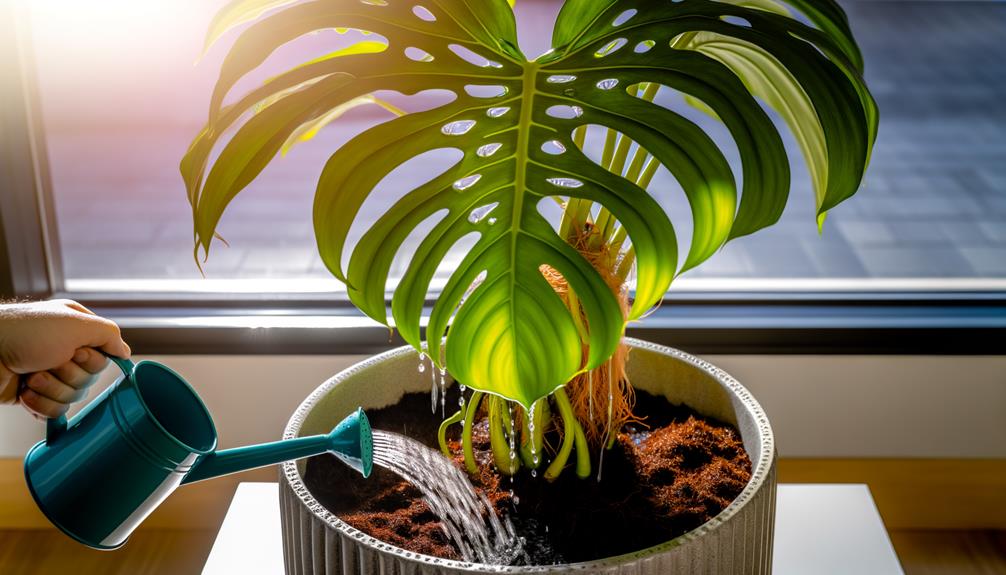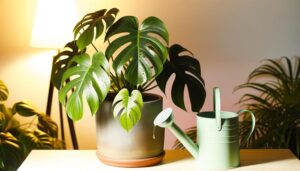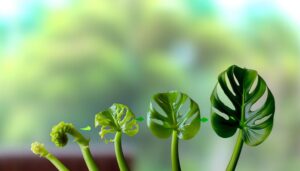Monstera Borsigiana Watering Tips
Keep your Monstera Borsigiana's soil consistently moist but not waterlogged. Check soil moisture regularly and water when the top inch is dry.
Water thoroughly until it drains out. Use well-draining soil and a pot with drainage holes.
Choose distilled or rainwater, avoiding high mineral content. Water in the morning to prevent root rot and reduce watering frequency in winter.
Signs of overwatering include yellowing leaves and root rot; wilting leaves suggest underwatering. Utilize a moisture meter to maintain ideal moisture levels, adjusting your schedule seasonally.
There's more to know about achieving peak growth.

Key Takeaways
- Water when the top 1-2 inches of soil are dry to maintain consistent moisture.
- Use well-draining soil and a pot with drainage holes to prevent root rot.
- Opt for distilled or rainwater to avoid mineral buildup and leaf spots.
- Water thoroughly in the morning until excess water drains from the pot.
- Reduce watering frequency in winter to prevent overwatering and root rot.
Understanding Water Needs
Understanding the water needs of Monstera borsigiana is crucial for maintaining its health and promoting ideal growth. This plant prefers a consistently moist substrate without becoming waterlogged. You'll need to monitor the soil's moisture level regularly.
Use your finger to check if the top inch of soil is dry; if it is, it's time to water. Overwatering can lead to root rot, while underwatering can cause leaves to yellow and wilt. Make sure you use well-draining soil and a pot with drainage holes to prevent water accumulation.
Humidity also plays a critical role, as Monstera borsigiana thrives in higher humidity levels. Consider misting the leaves or using a humidity tray to maintain peak conditions.
Best Time to Water
Watering your Monstera Borsigiana in the morning allows the soil to dry out during the day, preventing root rot.
In contrast, watering in the evening can be beneficial during hotter months as it reduces evaporation rates.
Seasonal adjustments are pivotal; reduce watering frequency in winter when growth slows.
Morning or Evening Routine
To maximize hydration and prevent fungal issues, it's best to water your Monstera Borsigiana in the early morning. This timing allows water to absorb efficiently before the day's heat intensifies, reducing evaporation.
Morning watering also minimizes the risk of fungal infections since leaves have ample time to dry. Here's why you should adopt an early morning routine:
- Optimal Absorption: Soil can absorb water more effectively, ensuring roots receive maximum hydration.
- Fungal Prevention: Drying during daylight hours prevents moisture from fostering fungal growth.
- Temperature Regulation: Cooler morning temperatures help maintain stable soil moisture levels.
Seasonal Watering Adjustments
As the seasons change, you must adjust your Monstera Borsigiana's watering schedule to accommodate varying temperature and humidity levels. In spring and summer, higher temperatures and increased light intensity mean the plant requires more frequent watering. Conversely, during fall and winter, lower temperatures and reduced light slow down growth, reducing water needs.
| Season | Frequency | Water Amount |
|---|---|---|
| Spring | Every 5-7 days | Moderate, ensuring drainage |
| Summer | Every 3-5 days | More, to keep soil moist |
| Fall | Every 10-14 days | Less, allowing slight drying |
| Winter | Every 14-21 days | Minimal, just to dampen |
Monitoring soil moisture is vital. Insert your finger into the soil; if the top 2 inches are dry, it's time to water.
Proper Watering Techniques
Nurturing your Monstera Borsigiana involves understanding its specific watering needs, including the ideal soil dampness level and frequency. You'll want to maintain a balance to avoid root rot.
- Soil Moisture: Use a moisture meter or check soil manually; aim for soil that's evenly damp but not waterlogged.
- Watering Frequency: Water when the top 1-2 inches of soil feel dry to the touch. Overwatering can lead to poor aeration and root issues.
- Watering Method: Water thoroughly until it drains out the bottom of the pot. Guarantee the pot has drainage holes to prevent water stagnation.
Signs of Overwatering
Observing your Monstera Borsigiana for signs of overwatering is essential to prevent root rot and promote healthy growth.
First, check for yellowing leaves, particularly those lower on the stem. This chlorosis indicates excess moisture disrupting nutrient uptake.
Next, feel the soil. If it's consistently soggy or emits a foul odor, your plant's roots may be drowning.
Inspect the roots if you suspect overwatering; mushy or blackened roots signify rot.
Additionally, note any mold or fungal growth on the soil surface, a common symptom of prolonged dampness.
Finally, if new growth appears wilted or stunted, your Monstera might be suffering from waterlogged roots.
Signs of Underwatering
If your Monstera Borsigiana exhibits wilting and drooping leaves, it's likely suffering from underwatering. Check the soil; if it's dry and crispy, the plant needs more moisture.
Make sure you water thoroughly until excess drains from the bottom to avoid dehydration.
Wilting and Drooping Leaves
You can identify under-watering in your Monstera Borsigiana by observing wilting and drooping leaves, which indicate the plant's distress. When your plant lacks sufficient water, its cells lose turgor pressure, causing leaves to droop.
To address this, follow these steps:
- Assess Soil Moisture: Use a moisture meter or your finger to check the top 2 inches of soil for dryness.
- Water Thoroughly: Make sure water reaches the root zone by watering until excess drains from the pot's bottom.
- Monitor Regularly: Check your plant weekly to maintain the best soil moisture levels.
Dry and Crispy Soil
When the soil of your Monstera Borsigiana becomes dry and crispy, it's a clear sign of underwatering that needs immediate correction. Insufficient moisture disrupts the plant's ability to transport nutrients, leading to stunted growth and leaf yellowing. To address this, maintain consistent watering practices, allowing the top inch of soil to dry before rewatering.
| Symptom | Cause | Solution |
|---|---|---|
| Dry, crispy soil | Underwatering | Water thoroughly until excess drains out |
| Yellow leaves | Nutrient transport | Maintain steady moisture levels |
| Stunted growth | Root dehydration | Rehydrate soil gradually |
| Leaf browning | Cellular desiccation | Increase humidity, mist leaves |
Regularly check soil moisture with a finger test or moisture meter. Avoid letting the soil dry completely, as this stresses the plant, compromising its health and essentiality.
Ideal Water Type
For peak Monstera Borsigiana health, use filtered or distilled water to avoid the harmful effects of chlorine and fluoride found in tap water. These chemicals can lead to leaf burn and nutrient uptake issues. Utilizing the appropriate water type guarantees your plant's best growth.
Here's a simple guide:
- Filtered Water: Reduces chlorine, chloramine, and other harmful substances.
- Distilled Water: Free from minerals and impurities, preventing salt buildup in the soil.
- Rainwater: Naturally soft and mineral-free, mimicking the plant's natural habitat.
Seasonal Watering Adjustments
Given the importance of appropriate water quality, adjusting your Monstera Borsigiana's watering schedule according to the seasons guarantees ideal hydration and health.
During the growing season—spring and summer—your plant's metabolic activities increase, necessitating more frequent watering. Aim to keep the soil consistently moist, but avoid waterlogging which can lead to root rot.
In contrast, during the dormant period—fall and winter—your Monstera's growth slows down, reducing its water requirements. You'll want to let the top inch of soil dry out between waterings. Also, consider the ambient humidity and temperature variations; higher temperatures and lower humidity may require slight adjustments.
Using Moisture Meters
Using a moisture meter can provide precise measurements of your Monstera Borsigiana's soil moisture levels, helping you avoid both under- and overwatering. This tool is essential for ensuring ideal hydration and promoting healthy plant growth.
To use a moisture meter effectively:
- Insert the probe: Gently push the probe into the soil about halfway between the stem and pot edge.
- Read the meter: Check the moisture level displayed. Most meters have a scale from 1 (dry) to 10 (wet).
- Act accordingly: If the reading is below 3, it's time to water. A reading above 7 indicates the soil is too wet.
Common Watering Mistakes
One of the most common watering mistakes for Monstera Borsigiana is failing to adjust the frequency based on seasonal changes. During winter, the plant's metabolic rate slows, requiring less water. Overwatering in this period can lead to root rot.
Conversely, in summer, higher temperatures and increased transpiration necessitate more frequent watering.
Another mistake is using water with high mineral content, which can cause leaf spots and nutrient imbalances. Opt for distilled or rainwater to avoid this issue.
Additionally, make sure your pot has proper drainage; stagnant water can suffocate roots and promote fungal growth.
Conclusion
Essentially, mastering Monstera borsigiana watering involves a balance between attentiveness and restraint. By observing your plant's subtle cues and adjusting your methods accordingly, you'll avoid the common pitfalls of overzealous hydration or neglect.
Employing moisture meters and understanding seasonal shifts can elevate your care routine. Remember, your plant's well-being hinges on your ability to fine-tune its aquatic environment, ensuring it thrives without falling victim to the more delicate consequences of improper watering.






